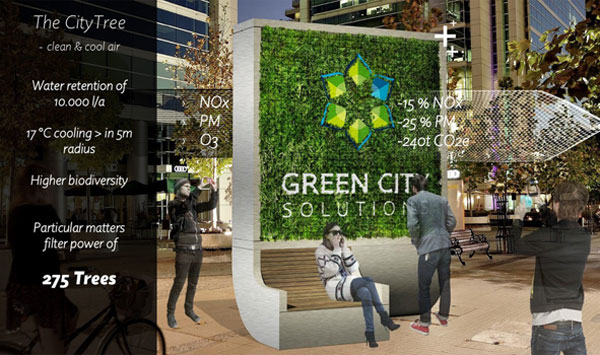University of Dresden is supporting the City Tree developers Victor Splittberger and Peter Sänger by using a special programme to research how pollution could be most effectively filtered from the air. The programme can be employed to numerous locations worldwide.

The CityTree structure is an amalgamation of sorts: a green, free-standing contraption that’s seemingly part tree sculpture, part park bench and part skate ramp. Its verdant wall stands about 13 feet high, and its square face stretches almost as wide. Yet despite its peculiar form, the installation has purpose. Its inventors claim it has the air-cleaning capacity of hundreds of trees.
“One CityTree is as effective in combating air pollution as 275 regular planted urban trees at 5 percent of the cost, and requires 99 percent less space,” said Dénes Honus, co-founder and CEO of Green City Solutions.
The City Trees are not only tested in Dresden, but also in Paris and Hong Kong. If the trial phase works well, the company founders hope the moss installations will become part of city scapes worldwide.

The moss is adaptable to the hardest and coldest places on the planet” states Peter Sänger. Furthermore the founder of the company highlights that one City Tree has the air cleansing effect of 50 trees in the smallest possible space.
Behind the branches of moss are two watering system, which ensure that the mosture is evenly distributed from top to bottom, so that the plants can grow ideally to filter and cool the air.

The idea is as simple as it is satisfying. The City Trees developed by a business startup in Dresden are actually sustainable green advertising panels. They can meet their own needs with rainwater collectors and solar panels that make them totally autonomous and virtually maintenance-free.
The manufacturer is relying primarily on mosses, whose many tiny leaves offer a much higher level of gas exchange than deciduous trees. One City Tree is designed to absorb about 30 kilograms of carbon dioxide – as much as 20 roadside trees – and 37 grams of particulate matter a year. And they also look good thanks to their evergreen moss and integrated park benches.
They are financed by advertising and offer space for lettering and QR codes. The project is being monitored by HTW Dresden, TU Dresden and Berlin’s Humboldt University. Prototypes are already operating in Saxony, and Berlin is next on the list. A total of 50 City Trees are scheduled to be “planted” in Germany
